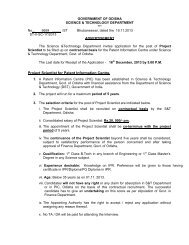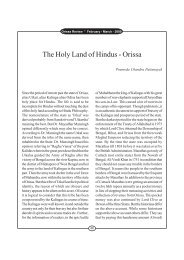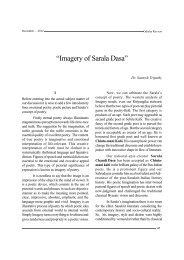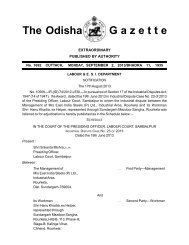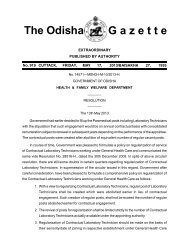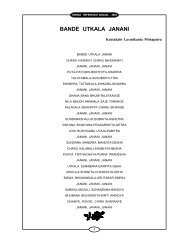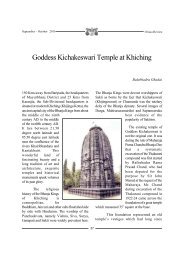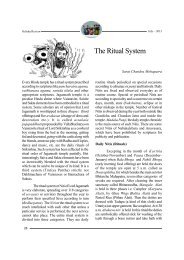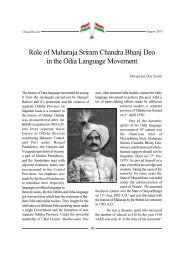Great Heritages of Orissa - Government of Orissa
Great Heritages of Orissa - Government of Orissa
Great Heritages of Orissa - Government of Orissa
You also want an ePaper? Increase the reach of your titles
YUMPU automatically turns print PDFs into web optimized ePapers that Google loves.
<strong>Orissa</strong> Review * December - 2004<br />
<strong>Great</strong> <strong>Heritages</strong> <strong>of</strong> <strong>Orissa</strong><br />
Etymologically, 'heritage' is anything that is or<br />
may be inherited. In such case 'heritage' covers<br />
everything that is seen around the human<br />
civilization. Heritage is thus natural or created<br />
or has evolved in the course <strong>of</strong> history. It is<br />
natural or man-made. Of the man-made<br />
heritages some are already made and existing<br />
and others are in the process <strong>of</strong> making. But<br />
everything what we inherit or may be inherited<br />
can not be heritage in the proper use <strong>of</strong> the<br />
term. To assume the dimension <strong>of</strong> heritage such<br />
features must have influenced the socioeconomic<br />
and cultural life <strong>of</strong> the people. It must<br />
have substantially influenced the imagination<br />
and life style <strong>of</strong> the human beings. A society<br />
or civilization is known and become unique<br />
by its own tradition. It gets its identity by its<br />
own heritages.<br />
Heritage is something which is specific<br />
and typical <strong>of</strong> a place, area, region or country<br />
on the one hand and <strong>of</strong> a family, community or<br />
people on the other. It may broadly be<br />
categorised under two heads. They are<br />
(a) Natural, (b) Cultural. Natural heritages<br />
include all the natural features like mountain,<br />
peaks, valleys, forests, deserts, water bodies,<br />
landscape, flora and fauna. In it we can include<br />
everything that is gifted to human being by<br />
nature good or bad, peaceful or terrible.<br />
37<br />
Dr. Hemanta Kumar Mohapatra<br />
Cultural heritages are the creation <strong>of</strong> human<br />
beings, who have created it by virtue <strong>of</strong> their<br />
innovative power, creativity, skill and artistic<br />
ability.<br />
Cultural heritages may be tangible or<br />
intangible. Archaeological heritages may be<br />
otherwise called tangible heritages. The<br />
intangible ones may be called living heritages.<br />
But for better comprehension and convenience<br />
we have discussed the cultural heritages in<br />
entirety under the following sections.<br />
(a) Archaeological heritages (b) Literary<br />
heritages (c) Religious heritages<br />
(d) Performing art heritages, (e) Heritage<br />
festivals (f) Art and craft heritages<br />
(g) Modern heritages <strong>of</strong> <strong>Orissa</strong>.<br />
The cultural dimension <strong>of</strong> <strong>Orissa</strong> is<br />
varied and wide. Every bit <strong>of</strong> Oriyan culture<br />
and tradition is not included in this discussion.<br />
But the existing monuments and the cultural<br />
activities which had shaped or is shaping the<br />
life style <strong>of</strong> the Oriya people are included in<br />
the perview <strong>of</strong> this feature. From this<br />
discussion the identity <strong>of</strong> the Oriyas and <strong>Orissa</strong><br />
can evolve in a proper and distinct form.<br />
However at first let us have a discussion on<br />
the natural heritages <strong>of</strong> <strong>Orissa</strong>.
<strong>Great</strong> Natural <strong>Heritages</strong> <strong>of</strong> <strong>Orissa</strong><br />
Nature has given everything to <strong>Orissa</strong>.<br />
Nature's bounties and glories are distinctly<br />
expressed through its gifts like beautiful<br />
beaches, mighty rivers, water streams and<br />
falls. In <strong>Orissa</strong> we have spectacular mountains<br />
and valleys as well as sprawling green field<br />
<strong>of</strong> plains. In <strong>Orissa</strong> nature is also bountiful for<br />
its wide varieties <strong>of</strong> flora and fauna.<br />
The widespread sandy sea beaches with<br />
roaring sea can best be observed at Puri,<br />
Gopalpur and Chandrabhaga (near Konark).<br />
Chandipur at sea has a special attraction. Here<br />
Bay <strong>of</strong> Bengal recedes and proceeds 5 km.<br />
everyday. It is a peaceful sea-side resort. At<br />
Puri, the Bay <strong>of</strong> Bengal is known as<br />
Mahodadhi and on the sea shore there is a place<br />
called Swargadwar which is very sacred for<br />
performing funeral rites.<br />
<strong>Orissa</strong> is rich with sacred rivers like the<br />
Mahanadi, Brahmani, Baitarani, Subarnarekha,<br />
Rushikulya and Indravati. Mountains like<br />
Deomali and Gandhamardana are well known.<br />
Deomali is the highest mountain peak <strong>of</strong> <strong>Orissa</strong><br />
and Gandhamardana is a sacred one. It is rich<br />
with rare spacies <strong>of</strong> flora and fauna. On the<br />
one side <strong>of</strong> Gandhamardana hill there is<br />
Harishankar and on the other side there is<br />
Nrusinghanath. Gonasika hills in Keonjhar<br />
district is known for the origin <strong>of</strong> the river<br />
Baitarani.<br />
There are a number <strong>of</strong> beautiful<br />
waterfalls in <strong>Orissa</strong>. They are Bada-Ghagara,<br />
Sana-Ghagara and Khandadhara in Keonjhar<br />
district, Barehipani waterfall in Similipal<br />
National Park, Pradhanpat (Deogarh), Phurli<br />
Jharan in Kalahandi, Duduma <strong>of</strong> Malkangiri<br />
etc. Khandadhar is the loveliest waterfall <strong>of</strong><br />
<strong>Orissa</strong>. The known natural hotsprings <strong>of</strong> <strong>Orissa</strong><br />
are Atri (Khurda), Taptapani (Ganjam) and<br />
Deulajhari (Angul).<br />
<strong>Orissa</strong> Review * December - 2004<br />
38<br />
To maintain the eco-balance and to<br />
protect the flora and fauna, national parks are<br />
earmarked at Similipal and Bhitarakanika <strong>of</strong><br />
<strong>Orissa</strong>. Besides these national parks, <strong>Orissa</strong><br />
has a number <strong>of</strong> wildlife sanctuaries. Similipal<br />
National Park in Mayurbhanj district is known<br />
for its Tiger Reserve. It has other wild animals<br />
and 231 species <strong>of</strong> birds. Bhitarakanika<br />
National Park (Kendrapara) which sprawled<br />
over 367 square km. is known for its protected<br />
mangrove forest. It has a wide variety <strong>of</strong><br />
animals and crocodiles. Gahiramatha beach is<br />
well known for its sea-turtles. Gharial<br />
sanctuary <strong>of</strong> Satkosia Ganda (Gorge) at<br />
Tikarpara is well known. Ushakothi wild life<br />
sanctuary near Sambalpur is known for its<br />
elephants, leopards, bisons and black panthers.<br />
Belghar (Phulbani ) and Chandka (Khurda) are<br />
known for elephants.<br />
Though Puri, Chandipur and Gopalpur<br />
are well developed summer resorts, the real<br />
natural summer resort and hill station is situated<br />
at Daringbadi <strong>of</strong> Kandhamala district.<br />
Daringbadi is nicknamed as the Kashmir <strong>of</strong><br />
<strong>Orissa</strong>, especially due to the snowfall in the<br />
winter-season.<br />
However the greatest natural heritage <strong>of</strong><br />
<strong>Orissa</strong> is the beautiful Chilka. Originally it is<br />
a salty lagoon.<br />
Utkal Kamala Bilas Dirghika - Maralamalini Nilambu<br />
Chilika, Utkalra Tuhi Charu Alankara-Ae Biswabhubane<br />
Shobhara Bhandara.<br />
Thus said the great oriya poet Radhanath<br />
Ray in his Kavya "Chilika", spread over 1100<br />
square km. Chilika is the largest inland lake <strong>of</strong><br />
India. It is dotted with a number <strong>of</strong> small and<br />
big islands. It has the richest variety <strong>of</strong> aquatic<br />
fauna. Its "Nalabana" is famous for its<br />
migratory birds in winter. One can see the<br />
Irrawady Dolphins in this lake at Satapara area.
Chilika is also well known for its fishing and<br />
boating. The other two lakes <strong>of</strong> <strong>Orissa</strong> are Sara<br />
and Ansupa.<br />
The famous Nandankanan Zoological<br />
Park and the Botanical garden adjacent to it<br />
have turned to be great heritages <strong>of</strong> <strong>Orissa</strong>.<br />
Endowed with a natural lake, it is known for<br />
the rare white tigers and migratory birds which<br />
nest here during winter. It has India's largest<br />
lion safari as well as a white tiger safari.<br />
Archaeological <strong>Heritages</strong> <strong>of</strong> <strong>Orissa</strong><br />
<strong>Orissa</strong> has around 4000 monuments and<br />
archaeological sites. They include prehistoric<br />
remains, Buddhist monasteries and structures<br />
like chaityas and stupas, Jain caves and<br />
temples, important inscriptions, Hindu temples<br />
and sculptures, ancient and medieval forts,<br />
palaces as well as colonial architecture.<br />
Cave paintings <strong>of</strong> Neolithic age is seen<br />
at Yogimath <strong>of</strong> Kalahandi district. Another<br />
prehistoric site is also located in the same<br />
district. The site is at Gudahandi and is known<br />
for cave painting. In the district <strong>of</strong> Keonjhar at<br />
a place called Sitabinjhi one can see ancient<br />
fresco paintings on a rock shelter called Ravan<br />
Chhaya.<br />
The Asokan inscriptions <strong>of</strong> Dhauli (near<br />
Bhubaneswar) and Jaugarh (Ganjam) had<br />
shaped the life pattern <strong>of</strong> Kalinga people in<br />
the ancient days. The hillock <strong>of</strong> Dhauli and the<br />
sideby river Daya reminds <strong>of</strong> the heroic<br />
Kalinga militia which showed great valour and<br />
courage preferring death to surrender. They<br />
fought the great Kalinga battle, were defeated<br />
at the hands <strong>of</strong> Magadhan soldiers but their<br />
heroism and sacrifice compelled the Magadhan<br />
emperer Asoka to renounce war once for all.<br />
A viswa Santi Stupa has been erected at Dhauli<br />
by the Japanese Nippan Baudha Sangha to<br />
<strong>Orissa</strong> Review * December - 2004<br />
39<br />
memorise the great event <strong>of</strong> Asoka's change<br />
from Chandasoka to Dharmasoka and his<br />
acceptance <strong>of</strong> Buddhism from Upagupta, a<br />
Buddhist Bhiskhyu.<br />
At Khandagiri and Udayagiri near<br />
Bhubaneswar rock-cut caves are seen. These<br />
caves were originally built for the Jain monks.<br />
The double storeyed Ranigumpha is the largest<br />
cave <strong>of</strong> this series and has ornate carvings. The<br />
Hatigumpha has the chronicle <strong>of</strong> King<br />
Kharavela carved on it. The glorious days <strong>of</strong><br />
powerful Kalinga empire under Kharavela are<br />
very much enlivened by this inscription in Pali<br />
language.<br />
Ratnagiri-Lalitgiri-Udayagiri hills near<br />
Kendrapara and their environs comprise a<br />
remarkable Buddhist complex around it. Hiuen<br />
Tsang, the chinese pilgrim found it to be the<br />
seat <strong>of</strong> a flourishing Buddhist university called<br />
Puspagiri. It had equal status with Takshyashila<br />
and Nalanda. Extensive ruins <strong>of</strong> brick pagodas,<br />
sculptured stone portals and esoteric Buddhist<br />
images testifying its ancient glory, have been<br />
unearthed. Ratnagiri is the gem <strong>of</strong> the complex.<br />
The magnificently carved door jamb <strong>of</strong> the<br />
Vihar and the superbly finished Buddha images<br />
form perhaps the greatest concentration <strong>of</strong> the<br />
post Gupta period Buddhist sculptures.<br />
The Kalinga style <strong>of</strong> temple architecture<br />
flourished from 7th to the 13th century A.D.<br />
The most important monuments <strong>of</strong> this period<br />
can be seen in and around Bhubaneswar and<br />
Puri. In Bhubaneswar alone there are more than<br />
500 temples and rightly it is called the 'temple<br />
city <strong>of</strong> India'. Bhubaneswar was a Saiva Pitha<br />
(centre <strong>of</strong> Saivism) and in most <strong>of</strong> the temples<br />
<strong>of</strong> this place, Siva is being worshipped as the<br />
principal deity. The Parasurameswara Temple<br />
built in 7th century A.D. was the earliest one.<br />
Other richly decorated and remarkable temples
<strong>of</strong> Bhubaneswar are Svarnajaleswar temple,<br />
Vaital temple. Mukteswara temple and its<br />
famous makar torana was built in 10th century<br />
A.D. The beautiful Rajarani temple was built<br />
in 11th century A.D. The great Lingaraj temple<br />
<strong>of</strong> Bhubaneswar was built in the same 11th<br />
century by Somavamshi ruler Jajati Keshari.<br />
The <strong>Great</strong> temple Srimandira <strong>of</strong> Lord<br />
Jagannath is another great monumental heritage<br />
<strong>of</strong> <strong>Orissa</strong>. Ganga ruler, Chodagangadev started<br />
the building <strong>of</strong> this temple and it was<br />
completed during the reign <strong>of</strong><br />
Anangabhimadev. This was built in 12th<br />
century A.D. The architectural marvel, reached<br />
its zenith with the building <strong>of</strong> the Sun Temple<br />
at Konark by Ganga ruler Narasinghadev. In<br />
fact it was the last specimen <strong>of</strong> the matured<br />
Kalinga style <strong>of</strong> architecture. This temple was<br />
designed as the chariot <strong>of</strong> the God Surya (Sun)<br />
and this chariot had 24 wheels. The Konark<br />
wheels, the Konark horses are the greatest<br />
symbols <strong>of</strong> <strong>Orissa</strong>n sculptural achievements.<br />
Besides these important monumental<br />
heritages the Oriyas were very much influenced<br />
by other architectural marvels as well.<br />
Chausathi yogini temple <strong>of</strong> Ranipur Jharial in<br />
the district <strong>of</strong> Balangir is a wonder in the world<br />
<strong>of</strong> archaeology. Nrusinghanath in the district<br />
<strong>of</strong> Sambalpur was built in the 15th century A.D.<br />
The architectural monuments <strong>of</strong> Prachi Valley<br />
which includes the Yogini temple <strong>of</strong> Hirapur<br />
have substantially influenced the lifestyle <strong>of</strong><br />
the Oriyan people around it. This Yogini temple<br />
<strong>of</strong> Hirapur is one <strong>of</strong> the four such temples in<br />
India. It has beautiful Yogini images carved<br />
from black chlorite.<br />
The other temples <strong>of</strong> <strong>Orissa</strong> with<br />
archaeological value are the temples <strong>of</strong><br />
Chandrasekhara Siva on the hill top <strong>of</strong> Kapilas<br />
(Dhenkanala), the Dhabaleswar temple in the<br />
<strong>Orissa</strong> Review * December - 2004<br />
40<br />
Mahanadi island on the north west side <strong>of</strong><br />
Cuttack, the cluster <strong>of</strong> temples at Sonepur<br />
(Suvarnapur) and Bhawanipatna.<br />
The archaeological remains <strong>of</strong> the forts<br />
and palaces found in <strong>Orissa</strong> are valuable<br />
heritage sites. These forts and palaces had<br />
influenced the life-style <strong>of</strong> the Oriyas in the<br />
past. They are the mute witnesses <strong>of</strong> past<br />
heroism <strong>of</strong> the Oriyas. The prominent <strong>of</strong> these<br />
forts were Barabati fort <strong>of</strong> Cuttack, the fort at<br />
Chatia (Amaravati Cuttack), the fort <strong>of</strong><br />
Sarangagarh, walled capital centre <strong>of</strong><br />
Sishupalgarh (near Bhubaneswar), Asurgarh<br />
fort (Kalahandi) and Raibania fort<br />
(Mayurbhanj). The palaces <strong>of</strong> erstwhile<br />
feudatory states also stand as mute witness to<br />
Gadajati rule in the pre-independence era.<br />
The Grand-road(Badadanda) <strong>of</strong> Puri is<br />
a great heritage <strong>of</strong> <strong>Orissa</strong>. It has in itself the<br />
Saradhabali, Balagandi and a number <strong>of</strong><br />
important places. This Badadanda is a mute<br />
witness to many a rise and fall <strong>of</strong> Oriya race.<br />
It has also seen a number <strong>of</strong> saints and sadhus<br />
and become sacred with their foot prints. It<br />
has also seen teerthayatris from different parts<br />
<strong>of</strong> world during their pilgrimage to Jagannath<br />
Dham. The <strong>Orissa</strong> State Museum <strong>of</strong><br />
Bhubaneswar is also a potential heritage<br />
centre.<br />
<strong>Great</strong> Literary <strong>Heritages</strong> <strong>of</strong> <strong>Orissa</strong><br />
Without going to the technical<br />
controversies we can safely assume that<br />
Charyapada or Baudhagana Doha formed the<br />
earliest rudiments <strong>of</strong> Oriya literature. And<br />
naturally they are the basic literary heritages<br />
<strong>of</strong> the Oriyas.<br />
Oriya literature with most <strong>of</strong> its vibrant<br />
characters emerged only in 12th century A.D.<br />
Some <strong>of</strong> the scholars considered Sishuveda and
Saptanga belonging to this century. The<br />
Sishuveda and the Saptangas were the works<br />
<strong>of</strong> Natha cult. One can see the amalgamation<br />
<strong>of</strong> Buddhism and Saiva cult in it.<br />
Rudrasudhanidhi <strong>of</strong> Abadhut Narayan<br />
Swami, which is a prose work composed in a<br />
poetic style, was a 13th centuy creation. It is<br />
religious and romantic describing the marriage<br />
between Siva and Parvati.<br />
However Oriya language in its rich and<br />
stylish form appeared in the magnum opus <strong>of</strong><br />
Oriya literature, the Mahabharat <strong>of</strong> Sarala<br />
Das. Sarala Das is called the Adikabi <strong>of</strong> Oriya<br />
literature. His Mahabharat was never a<br />
translation <strong>of</strong> the Sanskrit Mahabharat <strong>of</strong><br />
Vedavyasa. The theme was the same but it was<br />
completely oriyanised by the great poet <strong>of</strong><br />
<strong>Orissa</strong>. This Sarala Das also ccomposed the<br />
Chandi Purana and Vilanka Ramayan. The<br />
Kesab Koili is another great piece <strong>of</strong> Oriya<br />
literature which had influenced the cultural life<br />
style <strong>of</strong> the Oriyas.<br />
Some <strong>of</strong> the Oriya inscriptions <strong>of</strong> 13th,<br />
14th and 15th centuries are also valuable<br />
pieces <strong>of</strong> Oriya literary heritages. Such<br />
prominent inscriptions are -<br />
1. Laxmi - Narasingha Temple<br />
(Simanchalam) inscription <strong>of</strong> Bhanudev<br />
(1263-1269)<br />
2. Tamil-Oriya Bilingual Inscription <strong>of</strong><br />
Narasinghadev-IV (14th century)<br />
3. Puri Inscription <strong>of</strong> Anangabhimadev III<br />
1226 and 1237 A.D.<br />
Another great literary heritage <strong>of</strong> <strong>Orissa</strong><br />
is <strong>of</strong> course the 'Madalapanji', the temple<br />
chronicle <strong>of</strong> Sri Jagannath Temple.<br />
Madalapanji is a combination <strong>of</strong> history,<br />
legends and heresays. The Bhakti literature <strong>of</strong><br />
<strong>Orissa</strong> Review * December - 2004<br />
41<br />
late 15th century and 16th century developed<br />
by the Panchasakha poets <strong>of</strong> <strong>Orissa</strong> (Jagannath,<br />
Balaram, Achyuta, Anant and Yasovantta Das)<br />
became the life line <strong>of</strong> the contemporary and<br />
laterday Oriyas. The Bhagabat <strong>of</strong> Jagannath<br />
Das became a part and parcel <strong>of</strong> every Oriya<br />
household. Likewise the Ramayan <strong>of</strong> Balaram<br />
Das also caught the imagination <strong>of</strong> Oriya<br />
people.<br />
Oriya poetry continued to be the most<br />
powerful cultural force even after the<br />
Panchasakhas. In Ritiyuga poetic laws, canons,<br />
dictums got more importance. It became<br />
difficult for comprehension. But they continued<br />
to be popular. Especially the poems <strong>of</strong> Kabi<br />
Samrat Upendra Bhanja overcame almost all<br />
the spheres <strong>of</strong> Oriya life. It was sung by the<br />
scholars in the royal court. It was sung by the<br />
travellers on the road. The farmers recite his<br />
poems when ploughing in the corn-field. His<br />
songs were also sung in the inner chambers <strong>of</strong><br />
the royal palace as well as by the prostitutes<br />
when dancing.<br />
Gae tumbha gita sabhare pandita pathe pantha<br />
hrustamana / bile bole chasa, Antapure josa<br />
nrutyarange barangana // (Utkalmani Gopabandhu)<br />
"Baidehisa Vilas, "Labanyabati",<br />
"Kotibrahmandasundari",<br />
"Premasudhanidhi", "Kalakautuka",<br />
"Subhadraparinaya" were most notable<br />
creations <strong>of</strong> Upendra Bhanja.<br />
Other medieval poets, whose poems<br />
must be included in the list <strong>of</strong> "Oriya Literary<br />
Halls <strong>of</strong> fame" are Kabisurya Baladev Rath,<br />
Bhakta Charan Das and Brajanath Badajena.<br />
Brajanath Badajena is more known in Oriya<br />
literary circle for his prose "Chaturavinod".<br />
After the Ritiyuga there was a spectacular<br />
decline in the development <strong>of</strong> Oriya literature.
However the revival movement <strong>of</strong> Oriya<br />
literature started with Vyasakabi Fakir Mohan<br />
Senapati. He is also nick named as the<br />
Kathasamrat (the emperor <strong>of</strong> fiction). His<br />
novels and short stories not only influenced<br />
the style <strong>of</strong> Oriya literature, but also the lifepattern<br />
<strong>of</strong> Oriya society. His great novels were<br />
Chhamana Athagunth, Mamun, Lachama and<br />
Prayaschit. His stories were edited in<br />
Galpaswalpa. His autobiography<br />
Atmajeevanicharita may be considered as a<br />
piece <strong>of</strong> contemporary history.<br />
The great Oriya poets <strong>of</strong> this time were<br />
Radhanath Ray and Madhusudan Rao. The<br />
Kavya 'Chilika <strong>of</strong> Radhanath' formed the life<br />
stream <strong>of</strong> the Oriya people. Radhanath Ray<br />
composed many Kavyas as well as responsible<br />
for development <strong>of</strong> modern prose literature.<br />
Madhusudan Rao was a devotional poet and<br />
is known as Bhaktakabi. Swabhavakabi<br />
Gangadhar Meher, produced the sweet songs<br />
<strong>of</strong> Tapaswini which is known for its lyrical<br />
value as well as heartening theme <strong>of</strong> the<br />
banishment <strong>of</strong> Sita depicted in the Ramayan.<br />
The literature <strong>of</strong> later "Sabuja Yuga" and the<br />
romantic writings <strong>of</strong> Mayadhar Manasingh had<br />
created sensation in Oriya social life and<br />
naturally to be protected as heritage materials.<br />
The patriotic songs <strong>of</strong> the days <strong>of</strong> freedom<br />
struggle must be compiled and protected as<br />
great literary heritages <strong>of</strong> <strong>Orissa</strong>. The<br />
composer <strong>of</strong> such songs were Jatiyakabi<br />
Birakishore Das and Banchhanidhi Mohanty.<br />
In modern times the novels <strong>of</strong> Kanhu<br />
Charan could catch the imagination <strong>of</strong> the<br />
people. His novels, which became obviously,<br />
the literary heritages are Baliraja, Haa-anna,<br />
Kaa, Shasti etc. The Oriya literature was<br />
flooded with his popular novels, which are<br />
more than 60 in numbers. Kanhu Charan's<br />
younger brother Gopinath Mohanty is not as<br />
<strong>Orissa</strong> Review * December - 2004<br />
42<br />
popular as his elder brother. But from the critics<br />
point <strong>of</strong> view his writings are superior for<br />
which he was awarded Jnanapitha for his novel<br />
'Mati Matal'. But in literary circle he is more<br />
known for his novels like Paraja, Danapani,<br />
Dadibudha etc. Manoj Das is a story writer<br />
and could write with equal comfort in Oriya<br />
and English. His short stories are naturally the<br />
great heritages <strong>of</strong> Oriya literature. Sachi<br />
Routray received Jnanapitha, for a later book.<br />
But his poem "Chotamora Gaanti is a heritage<br />
poem and he is remembered in <strong>Orissa</strong> as a<br />
Chotamora Gaanti poet. The poems and the<br />
research articles on the tribals <strong>of</strong> Sitakanta<br />
Mohapatra has endeared him in the Oriya<br />
literary circle. The Jnanapitha prize awarded<br />
to him put him in the category <strong>of</strong> great Indian<br />
writers.<br />
Historical novels <strong>of</strong> Oriya literature like<br />
Nilasaila, Niladrivijaya, Krishavenire<br />
Sandhya, Sultana, Kharavela, Suryavamshi<br />
and Rajanandini have influenced the cultural<br />
life pattern <strong>of</strong> the Oriyas. Novels on<br />
mythological plot like Yajnaseni has also a<br />
special place in Oriya literary heritage.<br />
Popular novels <strong>of</strong> Bibhuti Patnaik and Prativa<br />
Ray have tremendous impact on the average<br />
Oriya readers. Naturally by way <strong>of</strong> their<br />
popularity they acquired heritagial value.<br />
Literary Heritage <strong>of</strong> <strong>Orissa</strong> in Sanskrit<br />
is richly displayed by the great Sanskrit works<br />
like the Panchatantra by Vishnusarma (5th<br />
Century AD) and the Geetagovinda <strong>of</strong> Sri<br />
Jayadev.<br />
Religious <strong>Heritages</strong> <strong>of</strong> <strong>Orissa</strong><br />
In the past <strong>Orissa</strong> had experienced the<br />
warmth <strong>of</strong> all the major religious streams.<br />
<strong>Orissa</strong> has basically a tribal religious tradition<br />
which moves round the worshipping <strong>of</strong> natural<br />
features as well as invisible forces which
creates sensation, fear and devotion in the minds<br />
<strong>of</strong> simple tribals. The multi-dimensional<br />
religious tradition <strong>of</strong> the tribals <strong>of</strong> <strong>Orissa</strong> must<br />
constitute a major force in the Religious<br />
<strong>Heritages</strong> <strong>of</strong> <strong>Orissa</strong>.<br />
By now Buddhism and Jainisim have<br />
little impact on Oriyas. But the monuments<br />
connected with such religions must be<br />
preserved as our tradition <strong>of</strong> great religious<br />
heritages. The capital city <strong>of</strong> Bhubaneswar is<br />
surrounded by Buddhist relics such as the<br />
Asokan monuments at Dhauli. The modern<br />
santistupa at Dhauli is another Buddhist<br />
heritage. In Jagannath cult itself one can see<br />
Buddhist influence. Ratnagiri, Lalitgiri and<br />
Udayagiri are well known for Buddhist culture.<br />
In Boudh the presence <strong>of</strong> a huge Buddha image<br />
has carved out a niche for the place in the<br />
Buddhist map <strong>of</strong> <strong>Orissa</strong>. Khandagiri and<br />
Udayagiri caves are the relics <strong>of</strong> Jaina tradition<br />
in <strong>Orissa</strong>.<br />
The Sakti-cult <strong>of</strong> <strong>Orissa</strong> is well<br />
manifested by the presence <strong>of</strong> so many<br />
Shaktipithas in <strong>Orissa</strong>. Such Shaktipithas are<br />
spreaded all over <strong>Orissa</strong>. Goddess Vimala <strong>of</strong><br />
Sri Jagannath temple complex, Puri, Goddess<br />
Mangla <strong>of</strong> Kakatpur, Maa Sarala <strong>of</strong> Jhankad,<br />
Maa Biraja <strong>of</strong> Jajpur, Goddess Charchika <strong>of</strong><br />
Banki, Maa Bhagabati <strong>of</strong> Banapur, Maa<br />
Samaleswari <strong>of</strong> Sambalpur are the prominent<br />
among them. The other Saktipithas are located<br />
at Konark (Ramachandi), Brahmagiri<br />
(Baliharachandi), Cuttack (Cuttack Chandi),<br />
Chilika (Maa Kalijai), Bhattarika (Goddess<br />
Bhattarika), Purushottampur (Tara Tarini),<br />
Ghatgaon (Tarini), Bhawanipatna<br />
(Manikeswari), Balangir (Pataneswari). There<br />
are also yogini temples at Hirapur and Ranipur<br />
Jharial. Vaital temple <strong>of</strong> Bhubaneswar is<br />
known for its goddess Chamunda.<br />
<strong>Orissa</strong> Review * December - 2004<br />
43<br />
Saivite monuments and Saivism<br />
developed around it are found scattered<br />
throughout <strong>Orissa</strong>. Most <strong>of</strong> the temples <strong>of</strong><br />
Bhubaneswar are Saiva shrines and God Siva<br />
is worshipped here in different form and<br />
manifestation. The prominent Siva temple <strong>of</strong><br />
Bhubaneswar are Kedareswar,<br />
Parsurameswar, Mukteswar, Swarnajaleswar,<br />
Megheswar, Brahmeswar and Lingaraj<br />
temples. In Puri we have Sriloknath temple.<br />
Another great Saiva pitha <strong>of</strong> <strong>Orissa</strong> is<br />
Dhabaleswar near Cuttack. Paramahanshanath<br />
Siva temple near Cuttack is also a known Saiva<br />
Pitha. The other well known Saiva pithas <strong>of</strong><br />
<strong>Orissa</strong> are Panchalingeswar (Nilagiri),<br />
Akhandalamani (Aradi), Chandaneswar,<br />
Bhawanisankar (Bhawanipatna), Pataleswar<br />
(Budhikumna-Kalahandi), Lord Birupakshya<br />
(<strong>of</strong> Chakapad-Phulbani), Harisankar (Balangir)<br />
Gupteswar (Koraput) and Shiva temple <strong>of</strong><br />
Huma.<br />
The Vaishnavism <strong>of</strong> <strong>Orissa</strong> has its<br />
greatest manifestation in the Sri Jagannath <strong>of</strong><br />
Puri. Besides, Vaishnab shrines can be seen at<br />
Bhubaneswar (Ananta Vasudev Temple),<br />
Remuna (Khirachora Gopinath), Sakhigopal<br />
(Sakhigopinath), Sabar Srikshetra, Koraput<br />
(Jagannath), Niali (Madhav), Jajpur (Sveta<br />
Varaha), Kendrapara (Balabhadra, Jagannath,<br />
Suvadra at Tulasi Kshetra) etc.<br />
The headquarters <strong>of</strong> Mahima cult is<br />
situated at Joranda (Dhenkanal). Mahima cult<br />
is an independent religious sect <strong>of</strong> <strong>Orissa</strong> and<br />
was popularised first by Mahima Gosain and<br />
then by the Mahima Sadhus. Bhima Bhoi, the<br />
poet, played a prominent role in popularising<br />
the philosophy <strong>of</strong> this religious cult. Ganapati<br />
is also worshipped in the Jagannath temple<br />
complex and at Mahavinayak pitha <strong>of</strong><br />
Chandikhol. In most <strong>of</strong> the temple complex <strong>of</strong><br />
<strong>Orissa</strong> one can find an image <strong>of</strong> Sri Ganesh.
Besides, in <strong>Orissa</strong> Hanuman is widely<br />
worshipped. Sidha Mahaveer <strong>of</strong> Puri and Siruli<br />
Mahaveer near Puri and Panchamukhi Hanuman<br />
at Cuttack are the most prominent Hanuman<br />
Pithas <strong>of</strong> <strong>Orissa</strong>. Hanuman Vatika <strong>of</strong> Rourkela<br />
is a modern day phenomenon. When Hanuman<br />
is worshipped, his lord Rama is also<br />
worshipped with veneration and devotion.<br />
Performing Art <strong>Heritages</strong> <strong>of</strong> <strong>Orissa</strong><br />
<strong>Orissa</strong> has a rich heritage <strong>of</strong> music,<br />
instrumental as well as vocal. She has her own<br />
style <strong>of</strong> music called Odissi. Champu,<br />
Chhanda, Chautisha form the basic material for<br />
this Odissi music. The vocal music performed<br />
by Nimain Charan Harichandan, Singhari<br />
Shyamsundar Kar, Balakrishna Das, Raghunath<br />
Panigrahi, Bhikari Bal and Sunanda Patnaik can<br />
be preserved as our traditional musical<br />
heritage. In Palligeet and modern vocal the<br />
songs <strong>of</strong> Akshaya Mohanty can be best<br />
preserved. Other great modern Oriya singers<br />
include Pranab Pattanaik and Sikander Alam.<br />
Odissi dance is one <strong>of</strong> the great classical<br />
dance styles <strong>of</strong> India. It is a refined form <strong>of</strong><br />
Gotipua and Mahari dance. The great<br />
exponents <strong>of</strong> this dance are Nrityaguru<br />
Kelucharan Mohapatra and Guru Pankaj<br />
Charan Das. Sunanda Panigrahi, Kumkum<br />
Mohanty and Sonal Mansingh are most famous<br />
Odissi dance performers. It is so popular world<br />
wide that Indians as well as foreigners are<br />
attracted to perform this dance by learning with<br />
the help <strong>of</strong> the Nrityagurus.<br />
Chhau is a sub-classical martial dance<br />
style. Mayurbhanj Chhau like its two other<br />
counterparts, Sareikella and Purulia Chhau, is<br />
another heritage wealth <strong>of</strong> <strong>Orissa</strong>. <strong>Orissa</strong> is<br />
also proud <strong>of</strong> a number <strong>of</strong> folk dances. The<br />
best known folk dances <strong>of</strong> <strong>Orissa</strong> are Ghoomra,<br />
Sambalpuri, Karama, Ghodanach,<br />
<strong>Orissa</strong> Review * December - 2004<br />
44<br />
Chadheianach, Kandheinach, Gaudanka Laudi<br />
Khela and Paik Nacha. Pala and Daskathia are<br />
very much indigenous to <strong>Orissa</strong>. The main<br />
singer <strong>of</strong> Pala is a Gahana or Gayak supported<br />
by a Bayak (the Player <strong>of</strong> Mridanga) and three<br />
or four palias (followers). Daskathia is<br />
performed by a Gahana and a palia. Daskathia<br />
is a musical instrument prepared from two<br />
pieces <strong>of</strong> wood producing rhythmic sound. The<br />
main gayaks <strong>of</strong> Pala and Daskathia must master<br />
the traditional poetry <strong>of</strong> Sanskrit and Oriya<br />
literature. Namasankirtan is another type <strong>of</strong><br />
song drama performed by the Oriya Vaishnavas,<br />
being influenced by Srichaitanya, the great<br />
Bhakti saint <strong>of</strong> India.<br />
In <strong>Orissa</strong> the tradition <strong>of</strong> Suaanga and<br />
Geetavinaya is very old. Baishnav Pani and<br />
Balakrishna Mohanty are well known for their<br />
Yatra Suaangas. Baishnava Pani himself wrote<br />
Suaangas and directed its stage performance.<br />
His Geetvinayas are well accepted by<br />
applauding Oriya audiences. The Operas,<br />
based on mythological, historical and social<br />
themes are performed by yatra troops in open<br />
air pendal. It is even now a days, very popular<br />
among the Oriya people. Amateur artists<br />
perform theatre on experimental and traditional<br />
topics in <strong>Orissa</strong>. There were also a few<br />
pr<strong>of</strong>essional theatre groups like Annapurna and<br />
Janata Rangamancha. They are dead. We failed<br />
miserably to preserve such traditions.<br />
Mughal Tamsha <strong>of</strong> Bhadrak, Prahallad<br />
Natak <strong>of</strong> Ganjam, and Ramaleela are also well<br />
known is <strong>Orissa</strong>. The Mughal Tamasha was<br />
written by Banshiballav Goswami. It was a<br />
caricature <strong>of</strong> the Mughal administration in<br />
<strong>Orissa</strong> and the dialogues were written in a<br />
mixed language (Sanskrit, Oriya, Bengali,<br />
Hindi, Persian and Urdu).
<strong>Great</strong> Heritage Festivals <strong>of</strong> <strong>Orissa</strong><br />
<strong>Orissa</strong> has her indigenous festivals like<br />
Makarasankranti, Panasankranti, Asokastami,<br />
Ramanavami, Raja, Rath Yatra, Bata Osha,<br />
Gamha Punei, Khudurukuni Osha, Bhai Jauntia,<br />
Ganesh Puja, Dasahara, Kalipuja, Gajalaxmi<br />
Puja, Kumar Purnima, Kartika Habisha, Bada<br />
Osa, Kartika Purnima / Boita Bandan, Basanta<br />
Panchami, Sivaratri, Manabasa, Dolaparva,<br />
Holi, Prathamastami, Janmastami and<br />
Sambadasami etc.<br />
Yatras, Melas and Mahotshavas are<br />
celebrated with much pomp and grandeur<br />
during such festivals or otherwise. The famous<br />
yatras <strong>of</strong> <strong>Orissa</strong> are as follows. Baliyatra <strong>of</strong><br />
Cuttack and Paradeep are celebrated with Boita<br />
Bandana on Kartika Purnima day in the memory<br />
<strong>of</strong> the sea-trade <strong>of</strong> the Kalingan Sadhabs.<br />
Thakurani Yatra in Brahmapur celebrated with<br />
much pomp. In this yatra the goddess leaves<br />
the temple sanctum and come to a common<br />
household as a mark <strong>of</strong> daughters home coming<br />
to her fathers home. Sitalasasthi Yatra <strong>of</strong><br />
Sambalpur is celebrated in the form <strong>of</strong> social<br />
marriage function <strong>of</strong> Siva and Parvati.<br />
Dhanuyatra <strong>of</strong> Baragada in enacted in open<br />
stage. The legend <strong>of</strong> Krishna visiting Mathura<br />
to see the Dhanuyatra <strong>of</strong> uncle Kansha is<br />
performed here. Amapalli village on the<br />
otherside <strong>of</strong> river Jira became Gopapur. Jira<br />
became Yamuna and Baragarh became the<br />
Mathura city <strong>of</strong> Kansha. Ratha yatra <strong>of</strong> Puri is<br />
well known. Following its spirit and tradition<br />
Ratha yatra is celebrated in different parts <strong>of</strong><br />
the province as well as in other places <strong>of</strong> the<br />
world. Rukunarath yatra <strong>of</strong> Bhubaneswar is<br />
celebrated on Asokastami Day. Dola Melana<br />
(congragation) is another tradition <strong>of</strong> <strong>Orissa</strong>.<br />
Harirajpur Melan is famous for its colourful<br />
cracker works. Ramanavami yatra <strong>of</strong><br />
Asureswar is also well known for its cracker<br />
<strong>Orissa</strong> Review * December - 2004<br />
45<br />
works and colourful procession <strong>of</strong> Rama,<br />
Laxman and Janaki escorted with hundreds <strong>of</strong><br />
Hanumans.<br />
For holy baths, Chandrabhaga<br />
Maghasaptami Mela, Vyasasarovar Mela, and<br />
Dasawamedhaghat Snan <strong>of</strong> Jajpur are famous.<br />
The Oriyas also have their holy dip in the sacred<br />
tanks <strong>of</strong> Bindu Sagar (Bhubaneswar), Narendra<br />
and Indradyumna tank <strong>of</strong> Puri.<br />
Mahasivaratri Utshab is an annual<br />
festival being celebrated in almost all the<br />
Saivapithas <strong>of</strong> <strong>Orissa</strong>. This festival <strong>of</strong><br />
Mahasivaratri falls on the 14th day <strong>of</strong> the dark<br />
half <strong>of</strong> Phalguna and is observed by the<br />
devotees by keeping fast and burning the sacred<br />
lamp till the Mahadeep reaches at the temple<br />
top in the midnight.<br />
The Gajalaxmi puja <strong>of</strong> Dhenkanal and<br />
Kendrapara, Dassahara <strong>of</strong> Cuttack, Jhulana<br />
Purnima <strong>of</strong> Puri and Cuttack, Kalipuja <strong>of</strong><br />
Bhadrak and Jajpur are also equally famous<br />
throughout the state. Taratarini Mela on the hill<br />
top (bank <strong>of</strong> the river Rushikulya) attracts<br />
thousands <strong>of</strong> devotees in the month <strong>of</strong> Chaitra.<br />
Among the tribals, Puspuni and Makar<br />
are celebrated with traditional festivities<br />
enriched with tribal dance and songs.<br />
Makarmela festival can best be observed at<br />
places like Kalijai, Atri, Ghatgaon, Keonjhar,<br />
Jashipur and Jagatsinghpur. Chaitra Parab<br />
(April) is celebrated with Chhau festival at<br />
Baripada on Mahavisuba Sankranti Day.<br />
Some <strong>of</strong> the Melas and Mahotshavas are<br />
organised by the government or sponsored by<br />
different organisation to attract tourists or to<br />
remind the world <strong>of</strong> the cultural heritages <strong>of</strong><br />
<strong>Orissa</strong>. In this discipline "Lok Mahotsava" is<br />
organised every year in the month <strong>of</strong> January<br />
at Gangadhar Mandap in Sambalpur.
Sambalpuri folk dances and musics are<br />
performed here for three days.<br />
In collaboration <strong>of</strong> Department <strong>of</strong><br />
Tourism and Culture, <strong>Government</strong> <strong>of</strong> <strong>Orissa</strong>,<br />
the district administration <strong>of</strong> Koraput organises<br />
"Parab" in the last week <strong>of</strong> the month <strong>of</strong> January<br />
every year. Odissi, different types <strong>of</strong><br />
folkdances, tribal dances are performed here.<br />
The tribal art and craft <strong>of</strong> Koraput also are<br />
displayed here.<br />
The Beach Festival <strong>of</strong> Puri in the month<br />
<strong>of</strong> February and the Konark festival in the month<br />
<strong>of</strong> December are well attended by the foreign<br />
tourists and the local spectators. These new<br />
festivals are fast becoming powerful tradition<br />
and heritages <strong>of</strong> <strong>Orissa</strong>. In course <strong>of</strong> time<br />
Konark Dance Festival is assuming the<br />
dimension <strong>of</strong> a national dance festival.<br />
<strong>Great</strong> Art and Craft <strong>Heritages</strong> <strong>of</strong> <strong>Orissa</strong><br />
<strong>Orissa</strong> is also known far her superb art<br />
and craft heritages. Traditional art <strong>of</strong> <strong>Orissa</strong> is<br />
best manifested in the paintings <strong>of</strong> walls and<br />
floor <strong>of</strong> the households. Such traditional art<br />
form is known as jhoti or chita. The walls and<br />
floors <strong>of</strong> Oriya household are beautifully<br />
decorated with jhoti especially in the festive<br />
occasion like Dussahara and Manabasa (The<br />
worship <strong>of</strong> Laxmi). The colour material<br />
prepared for the purpose is from the rice-paste<br />
and one earth paint called "Dhau" is used to<br />
decorate it with red colour.<br />
In the month <strong>of</strong> Kartika, Muruja (a colour<br />
powder) is prepared and pictures are drawn<br />
on the pedestal <strong>of</strong> tulasi plant (chaura).<br />
Chitakutta or tattooing is another art form <strong>of</strong><br />
<strong>Orissa</strong>. A tatto mark on a woman is believed<br />
to symbolise chastity. Some believe that it is a<br />
shield against the torture <strong>of</strong> Yama, the God <strong>of</strong><br />
death, or a means to salvation.<br />
<strong>Orissa</strong> Review * December - 2004<br />
46<br />
Miniature paintings in <strong>Orissa</strong> are well<br />
displayed in "Pattachitra". Pattachitras are<br />
based on religious themes. The artists <strong>of</strong><br />
Pattachitra use traditional materials to prepare<br />
durable and bright colours. The Pattachitra or<br />
Raghurajpur is praised throughout the world.<br />
The entire village folk <strong>of</strong> Raghurajpur are fine<br />
artisans and sculptors. Raghurajpur is a world<br />
heritage village. Palm-leaf manuscripts <strong>of</strong><br />
<strong>Orissa</strong> also contain beautiful pictures <strong>of</strong><br />
miniature paintings.<br />
The tribals like Saura, Kondhas and<br />
Santals decorate their houses with motifs <strong>of</strong><br />
flowers, birds and geometrical designs. On the<br />
occasion <strong>of</strong> animal sacrifice, the Sauras draw<br />
Ittals on their walls. Dream sequences are<br />
depicted through these Ittals.<br />
Rock paintings in <strong>Orissa</strong> are found at<br />
Ulapgarh and Vikramkhol in Sambalpur district,<br />
Manikmada and Ushakothi <strong>of</strong> Sundargarh<br />
district, Gudahandi and Yogimath <strong>of</strong> Kalahandi<br />
district, Ravana Chhaya at Sitabanjhi in<br />
Keonjhar district.<br />
Paintings on temple walls is another art<br />
style <strong>of</strong> <strong>Orissa</strong>. These paintings mostly follow<br />
the mural tradition. Allegorical, mythological<br />
and historical themes are depicted in these<br />
mural paintings. The two most important<br />
paintings inside the Jagannath temple complex<br />
are Kanchi Vijaya and Buddhavijaya.<br />
Dashavatara murals are also painted on the<br />
temple walls <strong>of</strong> different temples. The<br />
Anantasayana scene <strong>of</strong> Vishnu is also<br />
displayed in temple walls.<br />
In <strong>Orissa</strong>, painting tradition is broadly<br />
divided into three categories. They are Puristyle,<br />
Daskhin school and Champamala school.<br />
The Dakhini tradition is observed in places<br />
like Ghumusar, Khallikote, Dharokote, Tikkali<br />
and Manjusha. The Champamala school<br />
prevails in Sonepur and Sambalpur.
The handicrafts <strong>of</strong> <strong>Orissa</strong> having heritage<br />
value are the silverware and filigree works <strong>of</strong><br />
Cuttack, terracotta and pottery work, applique<br />
work <strong>of</strong> Pipili and horn work <strong>of</strong> Cuttack. <strong>Orissa</strong><br />
has a rich heritage <strong>of</strong> producing artistic<br />
handloom sarees. Sambalpuri sarees, Bamkei<br />
and Berhampuri patta, Khandua and Bapta<br />
sarees have mature and beautiful style. They<br />
have nation wide demand. In stone the<br />
sculptors <strong>of</strong> <strong>Orissa</strong> prepare decorative<br />
figurines like Alasa Kanya, Salabhanjika,<br />
Surasundari, Lekhika etc. Now a days the<br />
images <strong>of</strong> Ganapati, Radhakrushna, Hanuman<br />
are in great demand. Other handicrafts <strong>of</strong> <strong>Orissa</strong><br />
are sola pith work, lacquer work, zari work,<br />
glass beads, cloth garlands, camphor garlands,<br />
jute carpets, rush mats etc.<br />
The Modern Heritage Centres <strong>of</strong> <strong>Orissa</strong><br />
The life pattern <strong>of</strong> Oriya people is<br />
greatly influenced by newly established<br />
heritage centres. A centre <strong>of</strong> education started<br />
in the 19th century, Ravenshaw College may<br />
be called as a premier heritage centre <strong>of</strong> <strong>Orissa</strong>.<br />
The Satyavadi school at Sakhigopal which was<br />
established by Utkalmani Gopabandhu was<br />
another centre <strong>of</strong> learning and heritage. In this<br />
school, scholars like Acharya Harihara,<br />
Krupasindhu Mishra taught the pupils.<br />
Gopabandhu tried to develop a very different<br />
type <strong>of</strong> education system here. Utkal University<br />
came into existence only a few years before<br />
the independence. Other centres <strong>of</strong> excellence<br />
like OUAT (<strong>Orissa</strong> University <strong>of</strong> Agriculture<br />
and Technology), Sambalpur and Berhampur<br />
universities came after independence. By now<br />
after the establishment <strong>of</strong> sri Jagannath Sanskrit<br />
University at Puri, University <strong>of</strong> Culture at<br />
Bhubaneswar and two Universities (North<br />
<strong>Orissa</strong> University, Baripada and Fakirmohan<br />
University at Balasore), Biju Pattnaik<br />
<strong>Orissa</strong> Review * December - 2004<br />
47<br />
University <strong>of</strong> Technology (BPUT) Rourkela the<br />
number <strong>of</strong> Universities in <strong>Orissa</strong> comes to a<br />
sum total <strong>of</strong> 9. Other premier centre <strong>of</strong> learning<br />
and research in <strong>Orissa</strong> are CRRI (Central Rice<br />
Research Institute, Cuttack) CIFA (Central<br />
Institute <strong>of</strong> Freshwater Acquaculture,<br />
Kaushalyaganga). Regional Research<br />
Laboratory, Institute <strong>of</strong> Physics, Institute <strong>of</strong> Life<br />
Science, Regional Institute <strong>of</strong> Education,<br />
Pathani Samanta Planetarium are located at<br />
Bhubaneswar. National Institute <strong>of</strong> Technology<br />
is a premier technical institution situated at<br />
Rourkela. They are all shaping the life <strong>of</strong> the<br />
Oriyas for the future and are great heritage<br />
materials. Regional Plant Research Centre,<br />
Ekamra Kanan, Bhubaneswar is well known<br />
for its research in cactus. Kalanagar at<br />
Bhubaneswar is known for research and<br />
training in handicrafts.<br />
Besides these, a few major projects<br />
which changed the life style <strong>of</strong> the Oriyas in<br />
the modern times are the Hirakud Dam Project,<br />
Duduma Project and the recently developed<br />
Upper Kolab and Indravati proejcts. The big<br />
factories like RSP, NALCO, MIG Factory at<br />
Sunabeda are other great heritages <strong>of</strong> modern<br />
time. The INS Chilka, the Missile Testing<br />
Centre <strong>of</strong> Chandipur, the Charbatia air base<br />
and the Ordnance factory <strong>of</strong> Saintala are some<br />
<strong>of</strong> the great defence establishments located in<br />
<strong>Orissa</strong>. Barabati Stadium is the biggest sports<br />
complex in <strong>Orissa</strong> and very much proud <strong>of</strong> its<br />
heritage in connection with games and sports.<br />
Jawaharlal Nehru Indoor Stadium <strong>of</strong> Cuttack<br />
is another milestone in the development <strong>of</strong><br />
sports in <strong>Orissa</strong>. Birsa Munda Sports Hostel<br />
is known for producing world class hockey<br />
players for India.<br />
Paradeep Port, a major sea port <strong>of</strong> India,<br />
adds to the glories and greatness <strong>of</strong> the Oriyas.
It had opened the flood gate <strong>of</strong> sea trade and<br />
prosperity <strong>of</strong> <strong>Orissa</strong>. Gopalpur and Dhamra are<br />
two minor ports <strong>of</strong> <strong>Orissa</strong>.<br />
Such heritages give the Oriyas selfrespect,<br />
pride and self-confidence. These are<br />
our valuable possessions. We inherit them and<br />
we should preserve them well so that we can<br />
gift them to our future generation. We can utilise<br />
our natural heritages for economic and<br />
humanitarian benefit. But our natural heritages<br />
must continue to be unpolluted, undamaged and<br />
unexploited. It will be suicidal if we try to<br />
disturb the eco-balance out <strong>of</strong> greed and<br />
mindlessness. Our archaeological as well as<br />
some natural heritages can be exposed to<br />
tourism. But utmost care must be taken to<br />
maintain their originality and naturality. We<br />
must preserve our natural features, our flora<br />
and fauna. Necessary care must be taken to<br />
protect our archaeological monuments. If<br />
damaged in the course <strong>of</strong> the ravages <strong>of</strong> the<br />
<strong>Orissa</strong> Review * December - 2004<br />
48<br />
time they can be rebuilt in tune with their<br />
original architectural style. We have architects,<br />
sculptors and artisans amongst us. Due<br />
patronization must be <strong>of</strong>fered to our living<br />
cultural activities. There is a trend <strong>of</strong><br />
diminishing aesthetic sense amongst us. We<br />
are fast becoming materialistic and balancing<br />
everything in the term <strong>of</strong> money. But the cream<br />
<strong>of</strong> our culture must be protected irrespective<br />
<strong>of</strong> its monetary value. Market should be<br />
explored for the art and craft products so that<br />
the artisans can earn their livelihood and their<br />
artistic skill shall survive. We must protect our<br />
heritages for ourselves and for our next<br />
generation. Protection <strong>of</strong> our heritages is our<br />
naturally inherited responsibility. We must<br />
preserve them for our future generation. It is a<br />
sacred obligation.<br />
Dr. Hemanta Kumart Mohapatra lives at 23, Ekamra<br />
Villa, Jayadev Vihar, Bhubaneswar.<br />
Hon'ble Chief Minister Shri Naveen Patnaik unveiling the statue <strong>of</strong> Dr. Harekrushna Mahatab at<br />
<strong>Orissa</strong> Legislative Assembly premises on 3.12.2004. Shri Maheswar Mohanty, Hon'ble Speaker,<br />
Shri Biswabhusan Harichandan, Minister, Rural Development, Industries & Law and<br />
Shri Balabhadra Majhi, Minister, Scheduled Tribes & Scheduled Castes Development (Scheduled<br />
Tribes Development) are also present.



